https://www.youtube.com/watch?v=5hnyZJgZUbI
The 7 WORST Chess Openings (According To Stockfish)

Well , if you've had a chance to do that , the best move for white is actually F takes E five , which is a little bit interesting because if I was playing this game , I think I would probably take the G pawn because I don't want it to push forward on the night .
And actually , that's the second best move .
So both of these captures are very good for white .
This one does allow black , you might say some counter play because they can push this pawn to G four .
But Stockfish is solution is actually quite simple and , and pretty interesting , I think night to G one .
So we undeveloped the night because it can't really go anywhere else , right ?
All these squares are taken .
So we have to move it back and it does allow black , this little idea of taking here and then playing queen H four check and winning our H pond , which at first glance looks a little bit scary .
But after we play G three , queen takes H two .
Stockfish says that after rook to G two with tempo , we defend everything .

Queen has to move , let's say queen H five , we simply play the move D four and it's giving an evaluation of right around plus five for white .
And after this , you can see this strong central ponds um are just completely controlling this game .
I mean , this is amazing plus five and you're not actually up any material except for , well , you're not up any material .
It's just all it has to do with this strong central control and it just goes to show how important controlling the center is .
So going back , the big takeaway from this is when you play pawn moves like this on the side , you better have a really good reason , right ?
You should be fine fighting for control of the center , you should be developing your pieces .
And if you're going to play a move like this , not to mention now , if Black ever decides to castle over here , what , what's gonna happen to the king ?
Right ?
It , it's , it's wide open .
So really bad choice on Black's part .
I do not recommend the Seco gambit at all .
Right .
The next opening we're gonna look at is an opening known as the Mosquito Gambit .
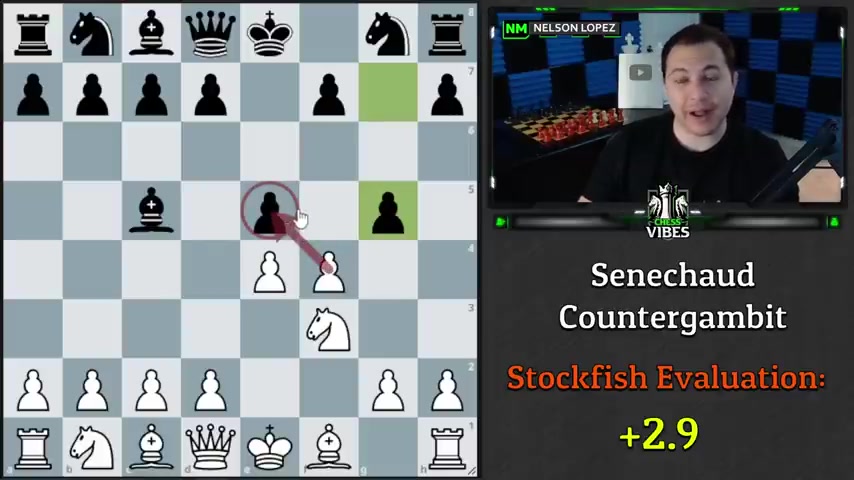
So it's D four E five , by the way , this is the England gambit .
And after we take it , black plays the crazy move queen to H four .
This is the mosquito gambit .
So again , I invite you to pause and think through what do you think Stockfish evaluation of the position is after black plays the move queen to H four .
And then also , while you're thinking about that , what do you think white's best response should be ?
Well , they had a chance to think through that .
Stockfish is evaluating this position as plus 3.7 .
So it's even more than a piece , which is crazy because we're actually only just up a pa but Stockfish is basically saying no , it's just like you're up apiece because this move is so bad .
So how should we approach this ?
The top stockfish move is knight to F three ?
And why is this such a good move ?
Well , it's developing a piece .
It's defending our pawn and it's gaining a tempo on the queen black now has to waste another move , moving their queen .

Next on the list , we have the Mado Visy gambit .
So here we go .
E four B , six D four bishop to B seven .
This is called the Owens defense .
By the way , where black immediately seeing Kettles the bishop here , putting pressure on this eon bishop to D three is one of the main lines , you just defend it with the bishop .
And now the move F five .
OK .
And Black is basically really trying to put pressure here .
And the idea is that if we take , which is what we're gonna do .
Black now has this move bishop takes G two .
And this is where we enter into the Mavis Gambit after queen H five check uh G six .
So I believe this is the first technical move in the Mavis Gambit .
Uh It's , it's the only legal move .
So you have to play there .
So , uh again , I invite you to pause .
What do you think the evaluation of this position is according to Stockfish ?

And what do you think White's best move or met best plan in this position should be if you had a chance to look at that according to Stockfish , this position is plus 4.5 for white .
That's almost the equivalent of being up a rook .
Remember rooks are five points .
So plus 4.5 very high .
And it has to do with the fact that yes .
OK .
Yes .
Black has this bishop .
Yes .
Our rook is trapped and we're probably going to be losing the rook .
But look at what ha what's happening to Black's king right now .
There's an interesting point about this opening and let's go ahead and talk through that .
So we're gonna take the pawn and of course , if Black tries to take back , well , then we just can take either way and it's checkmate immediately .
Right .
This is cooler , in my opinion because it's with the bishop , but either one is , is fine .
So black can't recapture .
They can try to play night F six to attack our queen .
But now we have a really nice finish .
I'll let you pause and think through , if you haven't seen this one before , it's worth taking the time to find it .
What can white play to win the game ?

And if you had a chance to look at that and want to see the solution G takes H seven opens up the queen with check .
Of course , the knight can take it .
But then this G six square is open for a bishop and we can deliver the mate really nice stuff .
And so we've seen this doesn't work .
Black gets mated .
This doesn't work .
Black gets mated .
Uh Of course , taking our rook also doesn't work .
We simply take and again , black gets mated .
So there's only really one , only really one idea that black has here and it's the move bishop to G7 .
And the point is that black is opening up the square for the king so that it's no longer a checkmate at the same time defending this rook , so that they are actually threatening now to take this because the rook is defended and we can still capture the king goes over .
And here is the point that black has .
And this is actually interesting because a lot of people who play this from the White side don't know what they should do in this position .
So , what do you think White should play in this position ?
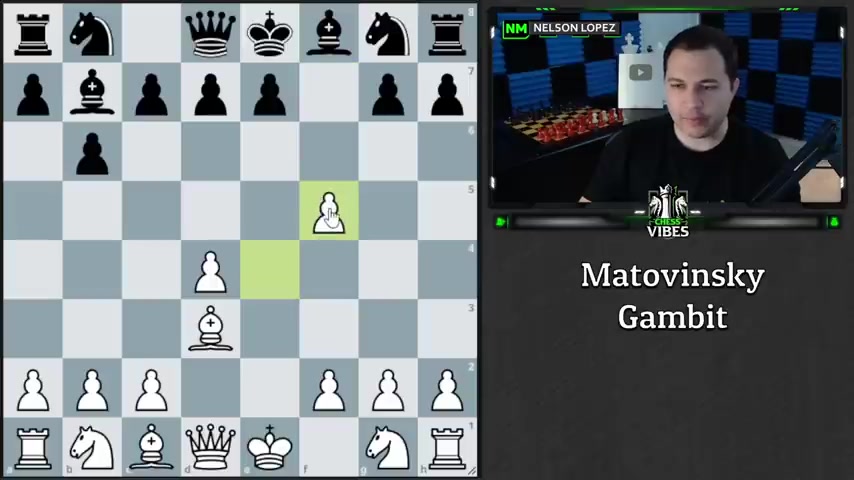
And after you had a chance to think through that , I'll tell you what the best plan is and what the plan that most people mistakenly think is , is the best move .
All right .
Well , if you had a chance to look at that , a lot of people think that the best move here is to capture the night because it's with check , you're winning a piece with check .
Why not take it right ?
The problem with this move is that after king takes white is still slightly better , but black actually does get quite a bit of compensation from this position because now your queen is attacked by the rook .
That's actually a pretty active rook , right ?
This bishop is actually pretty active .
White doesn't have an immediate way to take advantage of Black's king even though it's missing the pawns .
And so after we move the queen like queen to G four is the only real good move for white .
Black is gonna take this rook .
And it's an interesting position .
Like I said , technically , it's still slightly better for white , but black has a lot of counter play and compensation in this position and actually does quite well in practice .

So if we go back to this position right here , the interesting thing is that stockfish says taking the night is not the correct plan .
We shouldn't go that route because of what I just showed you black actually gets some nice compensation .
The move that stockfish recommends is Knight to H three just ignoring this night and saying , you know what ?
We don't want to let the rook come into the game .
We don't wanna have to waste time on our queen .
It's more important that we get these pieces out .
Right .
And now we're kind of forcing Black to make a decision .
If they want to take the rook , they have to do it now because if they don't take it right now , guess what ?
We're gonna play Rook G one and this rook's gonna come into the attack .
Now , of course , black can decide to take the night instead .
Um But let's go ahead and start with bishop .
Takes H one .
I think this is the most obvious move .
Now , we can see why Stockfish wanted to play nine H three knight to G five and we were threatening checkmate on F seven .
So Stockfish is basically saying , look , I don't even care about that night .

I'm going here for checkmate now , of course , night to age six can happen which stops checkmate and saves the night .
But what you'll notice is Black's king is kind of tied up a little bit more than it was previously .
Like before , once we took that the king was able to find some breathing room on G eight , the rook was involved .
Now , the rook's out of the game , our pawn is actually really annoying here on age seven , it's well defended .
It's controlling this square so the king can't escape there .
We've got these squares covered so very dangerous position for Blacks king .
And Stockfish says the evaluation at this position is plus five as opposed to the other one , it was maybe plus 1.5 , you know , if we took the night .
And so this is the correct plan and Stockfish just likes to move night to D two , just bring in another night .
And you know , I'm not gonna keep analyzing this position .
It's very good for white because of Black's precarious king placement .
The rook is stuck .
Um A lot of these pieces are kind of stuck and you know , black can't really do too much .

So I think we're gonna bring this night probably somewhere , get the bishop out castle and be on the lookout for tactical tricks and ideas depending on what Black is going to do .
So , going back , Mavis Gambit is tricky if you don't know what to do and you've never seen it before .
But if you understand the idea and it's really just like I said , just that one idea .
Bishop G7 um taking is fine here , but then don't take the night , OK , play night age three and you'll be completely winning .
OK ?
Next on the list , we have the Orsini Gambit now .
This comes out of the king's gambit .
So E four E five F four and it's the king's gambit accepted .
So black takes the pawn and now white plays the move B three right now .
Again , before we talk about what's going on here , I invite you to pause .
Try to think through what do you think stockfish evaluation of this position is ?
And what do you think the plan that black should take up should be ?
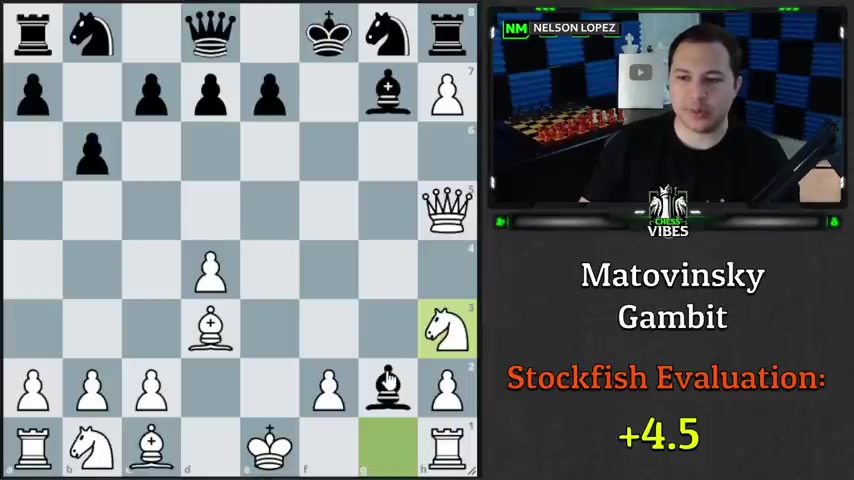
Well , if you had a chance to look at that , the evaluation from this position is minus three or minus 3.3 depending on how long you let stockfish analyze for minus three for black .
That's basically being up a piece even though we're not up apiece .
Why is that the case ?
Well , whenever you play the king's gambit , you are opening up this diagonal , right ?
Your king is in danger .
Now , most of the time in , in a normal king's gambit , you're gonna play night of three right away and night of three takes away the move queen H four from black because your knight would just take it right .
So that sort of protects you along that diagonal in this ori gambit B three does nothing to stop the queen .
And so this is what Black's plan should be queen to H four check and white has a big problem .
They only have two legal moves and both of them are really bad .
If you play G three , black takes it because this pawn here is , uh you know , obviously just controlling that square .
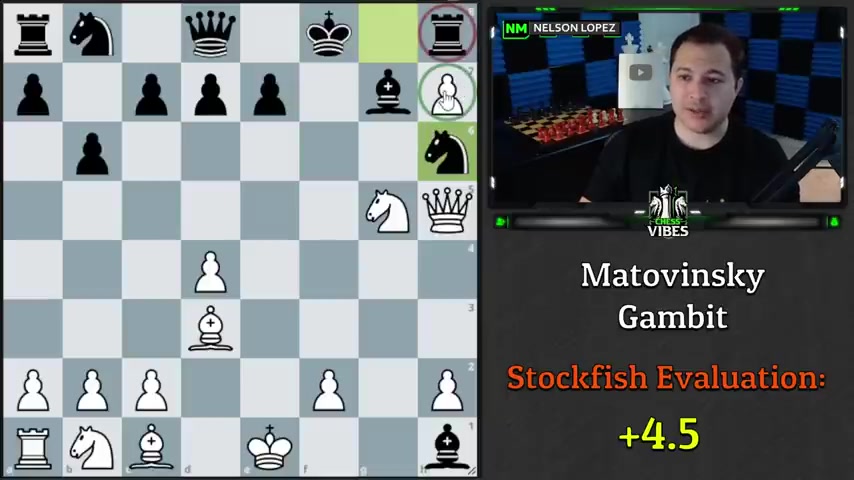
And so the point here is if you're going to play the king's gambit , you have to watch out for this move .
And B three just doesn't cut it .
You don't have time to do this kind of maneuver in the king's gambit .
It makes no sense at all .
Do not recommend the Orsini gambit at all .
Right .
Next up is the Frederico variation in the Sicilian .
So we have E four C five night of three G six .
Everything is normal .
So far D four , this is pretty main line stuff .
And then now we have the move F five .
This is the Frederico variation .
Now , uh before we talk about it again , if you want to pause and think through what do you think the evaluation is here and what should white's plan be ?
But they had a chance to think through that .
The evaluation that Stockfish gives is plus 3.7 for white .
So it's over a piece advantage .

And again , there's actually not any material advantage right now , but because this is such a bad move , that's why Stockfish is saying that .
So what should our plan be ?
Well , the best move is to just take this because now a black pretty much has to take you back or you're gonna just keep taking and keep opening up things .
And if they do , uh this diagonal is kind of a permanent weakness for black , which is really , really bad , right ?
It's a really big deal .
Now , the interesting thing is Stockfish doesn't say you should play a move like 95 to try to immediately go for it because if you play 95 A Black can simply play Night of six and you can't actually get there right away .
You can try Bishop G five and this is an OK attempt .
But Black has some options like E six .
And if you , let's just say , take it queen takes and you go for this check , well , the king actually just moves and you don't really have anything and actually now Black is better all of a sudden , right ?
So that's not the way that you want to approach it .
Like you don't want to force it like , oh , there's an open diagonal .

Everything that I do has to be revolved around that diagonal .
No , like Stockfish is plan in this position is just a simple 93 .
And this is a good point that I want to highlight sometimes when you play against these weird gambits , the best thing to do is just develop normally , like just make a normal developing move and wait for the opportunity .
You don't have to force it , right ?
So for example , NF six , bishop G five E six .
And then let's see what is Stockfish say now D five .
So you've kind of positioned some pieces nicely .
And now is when Stockfish says , hey , let's go for , try to break down some of the , the , the center here and see what we can do about Black's king .
So that's it .
That's the plan .
Um Let's just say something like bishop E seven .
Happens now , the night can come into E five and because you've just kind of slowed down and got some extra developing moves .
It's much more powerful and you have a lot more threats .
You've got D six , you've got captures here .
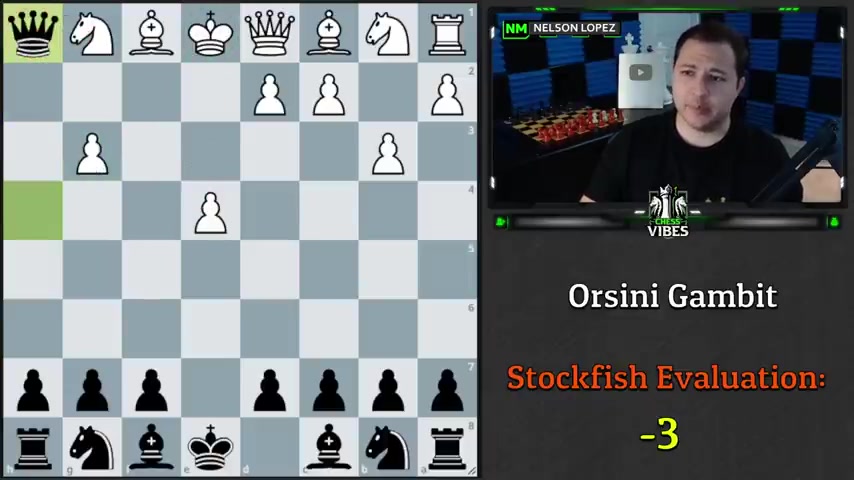
You even have ideas of potentially bringing this night over in D six and going to C seven , you still have this threat if you can get rid of the night , lots of things happening and it's much better than if you rushed it earlier , right ?
So going back to the beginning , Federico variation is a bad choice .
Please do not play this as black .
All right , next up , we have the Jerome gambit .
Now the Jerome gambit is E four , E 59 F 39 C six .
Bishop C four .
So this is the Italian game bishop C five .
A very common response by Black and the Jerome gamma is when white plays the move .
Bishop takes F seven check .
So it's a peace sacrifice .
Uh Well , before I talk about it again , what do you think the evaluation is ?
If you had a chance to look at that , it's minus five right now after the king takes stockfish changes it a little bit to minus 4.2 .
So almost a rook basically is what it's saying .

And the next move in the Jerome gambit is knight takes E five where you sacrifice another piece .
And the point here is that after black takes white would like to play queen to H five check and you can see there's a lot happening here .
It's a very tricky opening , even though it's not good .
Black does have to be careful .
So at this point in the game , I invite you to pause and think through what do you think Black's best move should be ?
And how should black proceed from here ?
Well , there's actually two good moves that you can play .
Now , according to Stockfish , the best option is to play king E six and defend your knight at least temporarily .
And then usually white will play F four to attack it .
And then Stockfish recommends giving back the piece by playing D six .
So you would allow this and recapturing it .
You get this position where you're still up a piece .
Remember , white sacrificed two pieces and you only had to give back one .
You're still up a piece .
You're gonna just continue developing night of six .
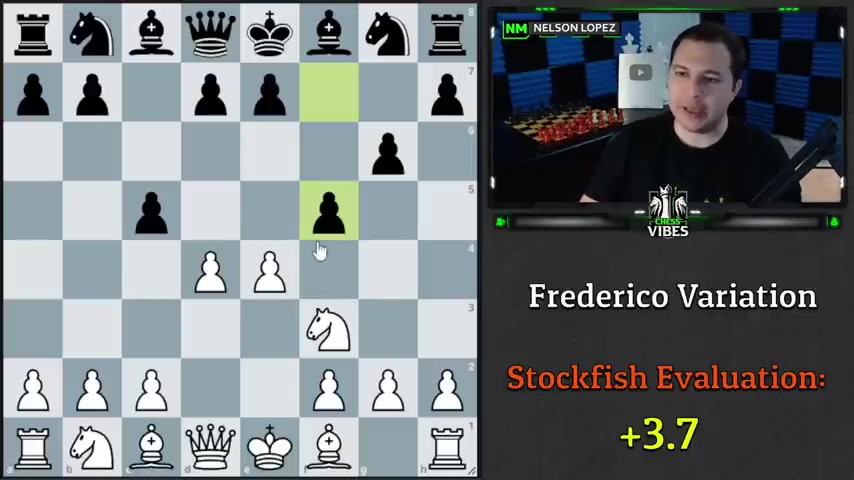
And again , there's actually not any material advantage right now , but because this is such a bad move , that's why Stockfish is saying that .
So what should our plan be ?
Well , the best move is to just take this because now a black pretty much has to take you back or you're gonna just keep taking and keep opening up things .
And if they do , uh this diagonal is kind of a permanent weakness for black , which is really , really bad , right ?
It's a really big deal .
Now , the interesting thing is Stockfish doesn't say you should play a move like 95 to try to immediately go for it because if you play 95 A Black can simply play Night of six and you can't actually get there right away .
You can try Bishop G five and this is an OK attempt .
But Black has some options like E six .
And if you , let's just say , take it queen takes and you go for this check , well , the king actually just moves and you don't really have anything and actually now Black is better all of a sudden , right ?
So that's not the way that you want to approach it .
Like you don't want to force it like , oh , there's an open diagonal .
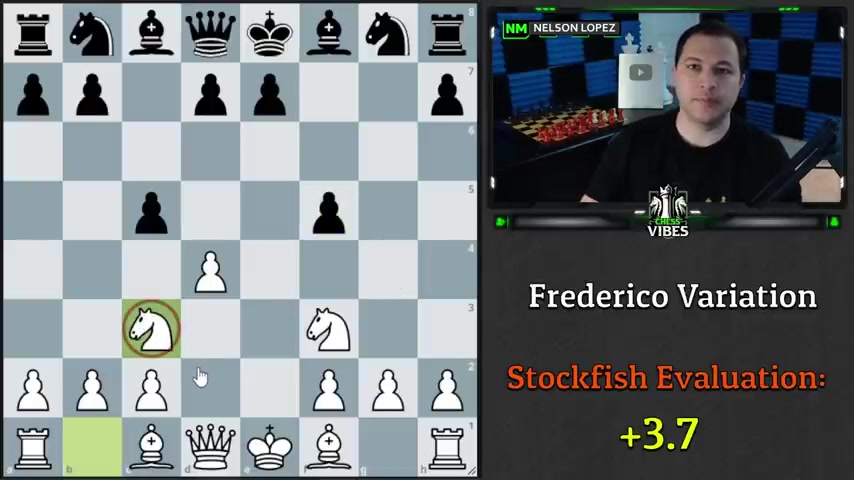
You know , bring out your pieces , your king has lots of places to run to and hide and white doesn't really have a lot of pieces left in the attack .
It's pretty much just the queen .
So you should be fine here .
That's one option .
Also in practice , a lot of people don't like to play this and so the other move that's pretty good is king to fa just kind of tucking your king back here giving up the night this way and then just playing a move like D six .
This is also pretty good for , for black .
For example , after queen of four , you can simply play queen of six , you know , try to trade queens because if you can trade queens , you have the extra piece and this is really good for black .
One thing that I want to point out is the most common move played here is knight to G six , which this is probably the worst option that you can play because now white has to move queen to G five check and they're gonna be able to take your bishop with check next move .
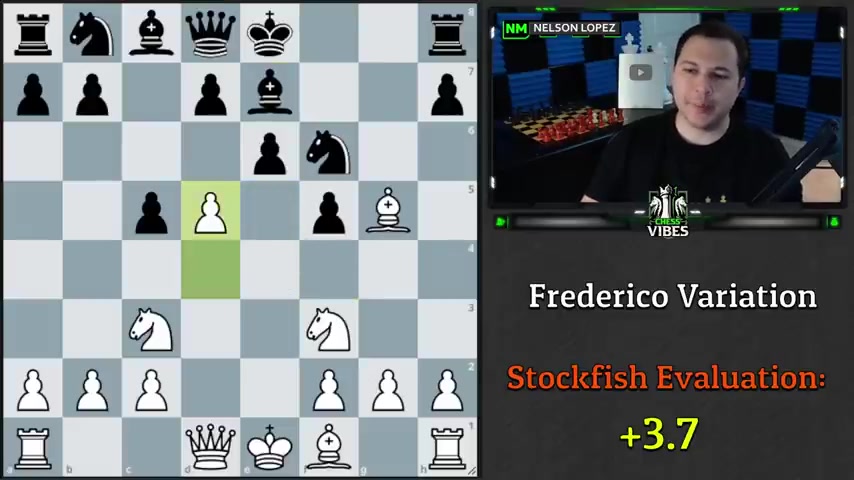
It's bad news for White .
This is not what White should be playing .
And it's funny because in this position after night of six , the best move according to Stockfish is to just go back to E one .
So , you know , your opening failed when you had to go here and then Stockfish says you better just go back .
Uh So I do not recommend Tumbleweed .
Please don't play the Drunken King variation .
And I hope you guys enjoyed this video of all these terrible gambits if you like this and you want to see more .
Let me know .
I didn't choose all of the bad gambits .
I did save uh some of them for another video .
If you guys like this type of thing , let me know .
And as always stay sharp , play smart and take care .
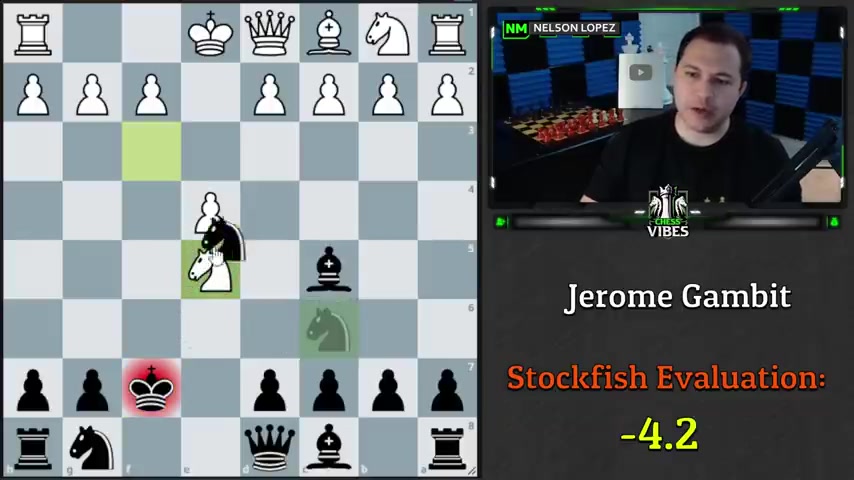
And the next move in the Jerome gambit is knight takes E five where you sacrifice another piece .
And the point here is that after black takes white would like to play queen to H five check and you can see there's a lot happening here .
It's a very tricky opening , even though it's not good .
Black does have to be careful .
So at this point in the game , I invite you to pause and think through what do you think Black's best move should be ?
And how should black proceed from here ?
Well , there's actually two good moves that you can play .
Now , according to Stockfish , the best option is to play king E six and defend your knight at least temporarily .
And then usually white will play F four to attack it .
And then Stockfish recommends giving back the piece by playing D six .
So you would allow this and recapturing it .
You get this position where you're still up a piece .
Remember , white sacrificed two pieces and you only had to give back one .
You're still up a piece .
You're gonna just continue developing night of six .

You know , bring out your pieces , your king has lots of places to run to and hide and white doesn't really have a lot of pieces left in the attack .
It's pretty much just the queen .
So you should be fine here .
That's one option .
Also in practice , a lot of people don't like to play this and so the other move that's pretty good is king to fa just kind of tucking your king back here giving up the night this way and then just playing a move like D six .
This is also pretty good for , for black .
For example , after queen of four , you can simply play queen of six , you know , try to trade queens because if you can trade queens , you have the extra piece and this is really good for black .
One thing that I want to point out is the most common move played here is knight to G six , which this is probably the worst option that you can play because now white has to move queen to G five check and they're gonna be able to take your bishop with check next move .

So for example , king F eight , they take on C five with check and you know , giving up that bishop gives white a little bit more of a chance to pawns against the night , even in like an end game has a better chance than against a bishop .
So slightly worse option .
Uh but even that is still better for black .
So I do not recommend the Jerome gambit .
Although to be completely honest with you guys , I have played this myself from time to time and it is , it is kind of fun .
So if you're playing speed chess one minute game , three many games , you can probably get away with this , but I wouldn't play it in an over the board , longer time control game , right .
Last , but certainly not least we have what is known as the Tumbleweed or also known as the drunken King variation .
So if you've never heard of that before , it's another opening that comes out of the king's gambit E four E five , F four .
King's gambit accepted .
And now white plays the move king to F two , the tumbleweed or like I said , the drunken king variation .
What's the point of this move ?

Well , uh I couldn't tell you .
It's a really bad move .
And again , if you'd like to pause , what do you think the evaluation of the position is ?
Well , according to Stockfish , it's minus 3.7 .
So black is already ahead over a piece .
And as far as the plan to take advantage of this , there's two of them that are very good .
Queen H four check is the most obvious and direct .
Of course , G three is no good because you can take and again , you're gonna be winning the rook .
So that's not really good .
And then , I mean , moving the king here also , we kind of saw this in the other opening with B three .
It's not what white wants to do , right ?
The other way you can take advantage of this .
Instead of queen H four , you can play knight to F six .
You're threatening here and here , not immediately there , you have to set it up with the bishop , but eventually that can be a threat .
This is an immediate threat , let's just say D three .
And now you can simply play D five , you're attacking like I said you're threatening to bring the night in .
You're threatening to bring the Bishop in .

It's bad news for White .
This is not what White should be playing .
And it's funny because in this position after night of six , the best move according to Stockfish is to just go back to E one .
So , you know , your opening failed when you had to go here and then Stockfish says you better just go back .
Uh So I do not recommend Tumbleweed .
Please don't play the Drunken King variation .
And I hope you guys enjoyed this video of all these terrible gambits if you like this and you want to see more .
Let me know .
I didn't choose all of the bad gambits .
I did save uh some of them for another video .
If you guys like this type of thing , let me know .
And as always stay sharp , play smart and take care .
Are you looking for a way to reach a wider audience and get more views on your videos?
Our innovative video to text transcribing service can help you do just that.
We provide accurate transcriptions of your videos along with visual content that will help you attract new viewers and keep them engaged. Plus, our data analytics and ad campaign tools can help you monetize your content and maximize your revenue.
Let's partner up and take your video content to the next level!
Contact us today to learn more.